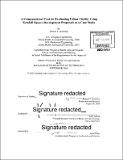| dc.contributor.advisor | Kent Larson. | en_US |
| dc.contributor.author | Gowharji, Waleed F | en_US |
| dc.contributor.other | Program in Media Arts and Sciences (Massachusetts Institute of Technology) | en_US |
| dc.coverage.spatial | n-us-ma | en_US |
| dc.date.accessioned | 2017-03-20T19:40:11Z | |
| dc.date.available | 2017-03-20T19:40:11Z | |
| dc.date.copyright | 2016 | en_US |
| dc.date.issued | 2016 | en_US |
| dc.identifier.uri | http://hdl.handle.net/1721.1/107562 | |
| dc.description | Thesis: S.M., Massachusetts Institute of Technology, School of Architecture and Planning, Program in Media Arts and Sciences, 2016. | en_US |
| dc.description | Cataloged from PDF version of thesis. | en_US |
| dc.description | Includes bibliographical references. | en_US |
| dc.description.abstract | Kendall Square, home to MIT, a world-class university and a district known globally for its reputation as an epicenter of ideas and innovation, has recently seen a new wave of development seeking to turn it into a place for people. Typically, multiple developers and private investors will bid on developing the area. The competitive nature of this process suggests that involved parties have varying and potentially conflicting objectives. For example, the soaring office and residential rents in Kendall Square make it attractive to private developers looking for monetary gains. Furthermore, in an area with an already high employment density, the addition of more office and commercial spaces could increase the stress on the public transportation system that is struggling to keep up with current demand. This becomes a design problem with no optimal solution. The question becomes, how do we design districts to be more livable for people? In this research we propose a computational evaluation decision support platform to facilitate collaborations between stakeholders in their interactions within the contexts of urban planning. Whether planned interventions or new developments, the aim of this research is to give stakeholders the ability to weigh the implications from these interventions on the vitality of districts. Chapter 1 lays the foundation of the theoretical contributions put forth by Jane Jacobs regarding urban vitality. Chapter 2 discusses the four-diversity conditions for urban vitality and early attempts to validate these conditions. Chapter 3 presents an overview of the urban elements of both Kendall Square and Harvard Square as a case study. In chapter 4 we apply Jacobs' vitality conditions to both case studies. We find that Harvard Square is balanced in terms of Jacobs' conditions, while Kendall Square suffered form an imbalance in residential density. Chapter 5 presents the computational evaluation platform "CityMatrix" and uses the Volpe and MIT development sites as examples of urban interventions. We find that the current plan, approximately 16,000 employees and 3,500 residents is not enough to increase the population density to make Kendall Square a more vital district. Lastly, chapter 6 provides a conclusion and future steps for this research. | en_US |
| dc.description.statementofresponsibility | by Waleed F. Gowharji. | en_US |
| dc.format.extent | 109 pages | en_US |
| dc.language.iso | eng | en_US |
| dc.publisher | Massachusetts Institute of Technology | en_US |
| dc.rights | MIT theses are protected by copyright. They may be viewed, downloaded, or printed from this source but further reproduction or distribution in any format is prohibited without written permission. | en_US |
| dc.rights.uri | http://dspace.mit.edu/handle/1721.1/7582 | en_US |
| dc.subject | Program in Media Arts and Sciences () | en_US |
| dc.title | A computational tool for evaluating urban vitality using Kendall Square development proposals as a case study | en_US |
| dc.type | Thesis | en_US |
| dc.description.degree | S.M. | en_US |
| dc.contributor.department | Program in Media Arts and Sciences (Massachusetts Institute of Technology) | en_US |
| dc.identifier.oclc | 974641087 | en_US |
